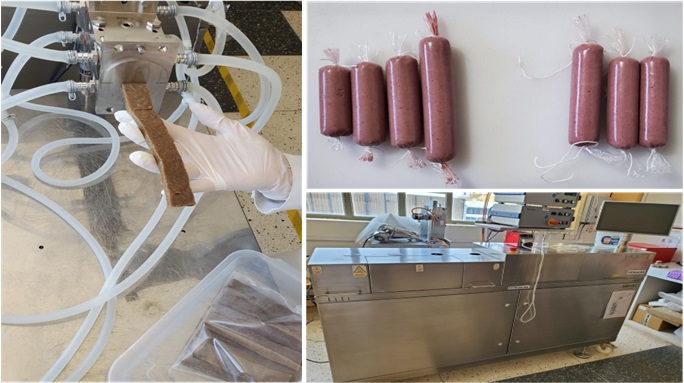Propriedades físicas de análogos de salsicha elaborados com farinhas de quinoa e cañihua, por extrusão
Resumo
As salsichas são enchidos amplamente consumidos em todo o mundo. O objetivo da pesquisa foi avaliar as propriedades físicas (cor, textura, rendimento na cozedura, redução do diâmetro) e a aceitabilidade de análogos de salsicha preparados a partir de análogos de carne, utilizando extrusão de alta umidade. Foram elaborados dois análogos de salsicha incluindo em sua formulação misturas de farinhas de quinoa (QF) e cañihua (KF) com isolado proteico de soja, em diferentes proporções, SA-1 (15 % QF, 15 % KF) e SA-2 (25 % QF, 15 % KF). A cor foi avaliada por análise de imagens; a textura por análise do perfil de textura; o rendimento de cozimento e a redução do diâmetro por relações de peso e dimensão. Para efeitos de comparação, foram utilizadas salsichas comerciais de frango e porco. As SA-1 apresentaram dureza de ~64 N, ~0,30 coesão, ~0,65 elasticidade e ~14 N mastigabilidade, valores semelhantes aos das salsichas de frango. A cor das SA-1 e SA-2 foi semelhante à das salsichas de frango, tonalidade ~318 ° e saturação entre 12,54 e 15,89 %. O rendimento de cozimento dos SA-1 apresentou um valor de ~93 %, superior ao das salsichas comerciais (~86 %). Sensorialmente, os SA-1 obtiveram uma avaliação comparável à das salsichas de porco e frango. O SA-1 apresentou propriedades físicas semelhantes às salsichas comerciais de frango, demonstrando a possibilidade de elaborar este tipo de produtos.
Downloads
Referências
Ahmad, M., Qureshi, S., Akbar, M. H., Siddiqui, S. A., Gani, A., Mushtaq, M., Hassan, I., & Dhull, S. B. (2022). Plant-based meat alternatives: Compositional analysis, current development and challenges. Applied Food Research, 2(2), 100154. https://doi.org/10.1016/J.AFRES.2022.100154
Alvis, A., Vélez, C., & Arrázola, G. (2010). Efecto de las condiciones de freído sobre la pérdida de humedad y ganancia de aceite en trozos de ñame (Dioscorea alata). Ingeniería e Investigación, 30(1), 41–44. https://www.redalyc.org/articulo.oa?id=64312498008
Bartolo, D. E. (2013). Propiedades nutricionales y antioxidantes de la cañihua (Chenopodium pallidicaule Aellen). Revista de Investigación Universitaria, 2(1), 47–53. https://revistas.upeu.edu.pe/index.php/riu/article/view/713
Bazile, D., Biaggi, M. C., & Jara, B. (2021). Quinoa’s Spreading at Global Level: State of the Art, Trends, and Challenges. Biology and Biotechnology of Quinoa: Super Grain for Food Security, 1–15. https://doi.org/10.1007/978-981-16-3832-9_1
Bertram, H. C., Aaslyng, M. D., & Andersen, H. J. (2005). Elucidation of the relationship between cooking temperature, water distribution and sensory attributes of pork – a combined NMR and sensory study. Meat Science, 70(1), 75–81. https://doi.org/10.1016/J.MEATSCI.2004.12.002
Bolívar-Monsalve, J., Ramírez-Toro, C., Bolívar, G., & Ceballos-González, C. (2019). Mechanisms of action of novel ingredients used in edible films to preserve microbial quality and oxidative stability in sausages - A review. Trends in Food Science & Technology, 89, 100–109. https://doi.org/10.1016/J.TIFS.2019.05.011
Contardo, I., Parada, J., Leiva, A., & Bouchon, P. (2016). The effect of vacuum frying on starch gelatinization and its in vitro digestibility in starch–gluten matrices. Food Chemistry, 197, 353–358. https://doi.org/10.1016/J.FOODCHEM.2015.10.028
Fernández-López, J., Viuda-Martos, M., & Pérez-Alvarez, J. A. (2021). Quinoa and chia products as ingredients for healthier processed meat products: technological strategies for their application and effects on the final product. Current Opinion in Food Science, 40, 26–32. https://doi.org/10.1016/J.COFS.2020.05.004
Ferreira Corrêa, P., da Silva, F. C., Ferreira, J. P., & Campos Guerra, J. (2023). Vegetable-based frankfurter sausage production by different emulsion gels and assessment of physical-chemical, microbiological and nutritional properties. Food Chemistry Advances, 3, 100354. https://doi.org/10.1016/j.focha.2023.100354
Flores, M., & Piornos, J. A. (2021). Fermented meat sausages and the challenge of their plant-based alternatives: A comparative review on aroma-related aspects. Meat Science, 182, 108636. https://doi.org/10.1016/J.MEATSCI.2021.108636
Gutierrez-Varas, M. A., & Siche, R. (2022). Producción de salchichas saludables: Una revisión de los sustitutos de origen vegetal para grasa, carne y sales. Manglar, 19(4), 379–389. https://doi.org/10.57188/MANGLAR.2022.048
Hermann, M. (2009). The impact of the European Novel Food Regulation on trade and food innovation based on traditional plant foods from developing countries. Food Policy, 34(6), 499–507. https://doi.org/10.1016/J.FOODPOL.2009.08.005
Herrero, A. M., de la Hoz, L., Ordóñez, J. A., Herranz, B., Romero de Ávila, M. D., & Cambero, M. I. (2008). Tensile properties of cooked meat sausages and their correlation with texture profile analysis (TPA) parameters and physico-chemical characteristics. Meat Science, 80(3), 690–696. https://doi.org/10.1016/J.MEATSCI.2008.03.008
Hleap, J., & Rodriguez, G. (2015). Propiedades texturales y sensoriales de salchichas de tilapia roja (Oreochromis sp.) con adición de harina de chontaduro (Bactris gasipaes). Ingeniería y desarrollo, 33(2), 198-215. https://doi.org/10.14482/inde.33.2.6332
Huang, Q., Xiong, K., Wang, Y., Xiong, Z., Lu, H., Peng, L., Jin, W., Wang, W., Ni, L., & Wang, H. (2025). Physical and flavor characteristics of reduced sodium sausages containing plant proteins and blends of chloride salts. LWT, 215. https://doi.org/10.1016/j.lwt.2024.117268
Isaza Rengifo, J. M., Londoño Ramírez, L. M., Restrepo Molina, D. A., Cortes Rodríguez, M., & Suárez Mahecha, H. (2010). Producción y propiedades funcionales de plasma bovino hidratado en embutido tipo salchichón. Revista Colombiana de Ciencias Pecuarias, 23(2), 199-206. http://www.scielo.org.co/scielo.php?script=sci_arttext&pid=S0120-06902010000200009
Kyriakopoulou, K., Dekkers, B., & van der Goot, A. J. (2019). Plant-Based Meat Analogues. Sustainable Meat Production and Processing (pp. 103–126). Elsevier. https://doi.org/10.1016/B978-0-12-814874-7.00006-7
Medina, W., Skurtys, O., & Aguilera, J. M. (2010). Study on image analysis application for identification Quinoa seeds (Chenopodium quinoa Willd) geographical provenance. LWT - Food Science and Technology, 43(2), 238–246. https://doi.org/10.1016/J.LWT.2009.07.010
Meijer, G. W. (2025). Nutrition and food science & technology: Vital symbiosis for sustainable health. Future Foods, 11. https://doi.org/10.1016/j.fufo.2025.100593
Montero-Castillo, P. M., Acevedo-Correa, D., Jaimes-Morales, J., Montero-Castillo, P. M., Acevedo-Correa, D., & Jaimes-Morales, J. (2022). Vacuum frying optimization for sausages with added chickpea flour. Información Tecnológica, 33(3), 97–106. https://doi.org/10.4067/S0718-07642022000300097
Ospina Meneses, S. M., Restrepo Molina, D. A., & López Vargas, J. H. (2011). Derivados cárnicos como alimentos funcionales. Revista Lasallista de Investigación, 8(2), 163–172. http://www.redalyc.org/articulo.oa?id=69522607018
Ozturk, O. K., & Hamaker, B. R. (2023). Texturization of plant protein-based meat alternatives: Processing, base proteins, and other constructional ingredients. Future Foods, 8, 100248. https://doi.org/10.1016/J.FUFO.2023.100248
Polizer Rocha, Y. J., Lorenzo, J. M., Barros, J. C., Baldin, J. C., & Trindade, M. A. (2019). Effect of chicken meat replacement by spent laying hen meat on physicochemical properties and sensorial characteristics of fresh sausage. British Poultry Science, 60(2), 139–145. https://doi.org/10.1080/00071668.2019.1568392
Ramos, M., Santolalla, S., Tarrillo, C., Tuesta, T., Jordán, O., & Silva, R. (2021). Physicochemical characteristics, texture, color and sensory attributes of commercial chicken sausages. Revista U.D.C.A Actualidad and Divulgacion Cientifica, 24(1). https://doi.org/10.31910/RUDCA.V24.N1.2021.1863
Schmidt, M. M., Dornelles, R. C. P., Vidal, A. R., Fontoura, A., Kubota, E. H., Mello, R. O., Kempka, A. P., & Demiate, I. M. (2017). Development of cooked and smoked chicken sausage with reduced sodium and fat. Journal of Applied Poultry Research, 26(1), 130–144. https://doi.org/10.3382/JAPR/PFW054
Shin, D. J., Lee, H. J., Lee, D., Jo, C., & Choe, J. (2020). Fat replacement in chicken sausages manufactured with broiler and old laying hens by different vegetable oils. Poultry Science, 99(5), 2811–2818. https://doi.org/10.1016/J.PSJ.2020.01.008
Sucasaca, A., Leon, A. M., & Medina, W. T. (2025). Inclusion of llaska (Cladophora crispata) flour in the development of a low-firmness meat analogue using high-moisture extrusion technology. CYTA - Journal of Food, 23(1). https://doi.org/10.1080/19476337.2025.2499739
Torres, J., Acevedo, D., & Armesto, D. (2015). Análisis de la calidad bromatológica, microbiológica, sensorial y de textura de bollos de mazorca cocidos en ebullición. Revista ReCiTeIA, 14(2), 7-16. https://www.researchgate.net/publication/283352406
Torres, J., Gonzales, K., & Acevedo, D. (2015). Análisis del perfil de textura en frutas, productos cárnicos y quesos. Revista ReCiTeIA, 14(2), 63-75 https://www.researchgate.net/publication/283352303
Troy, D. J., & Kerry, J. P. (2010). Consumer perception and the role of science in the meat industry. In Meat Science (Vol. 86, pp. 214–226). https://doi.org/10.1016/j.meatsci.2010.05.009
Wan Rosli, W. I., Solihah, M. A., Aishah, M., Nik Fakurudin, N. A., & Mohsin, S. S. J. (2011). Colour, textural properties, cooking characteristics and fibre content of chicken patty added with oyster mushroom (Pleurotus sajor-caju). International Food Research Journal, 18(2) 612-618. https://www.researchgate.net/publication/287225216
Watts, B. M., Ylimaki, G. L., Jeffery, L. E., & Elias, L. G. (1989). Basic sensory methods for food evaluation. 160. https://idl-bnc-idrc.dspacedirect.org/handle/10625/2844
Wong, K. M., Corradini, M. G., Autio, W., & Kinchla, A. J. (2019). Sodium reduction strategies through use of meat extenders (white button mushrooms vs. textured soy) in beef patties. Food Science & Nutrition, 7(2), 506–518. https://doi.org/10.1002/FSN3.824
Wu, H., Sakai, K., Zhang, J., & McClements, D. J. (2024). Plant-based meat analogs: color challenges and coloring agents. Food, Nutrition and Health 2024 1:1, 1(1), 1–19. https://doi.org/10.1007/S44403-024-00005-W
Wu, Y., & Guo, Q. (2025). Effect of whey protein on the formation, structure and gastrointestinal breakdown of quinoa flour-based composite gels. Food Hydrocolloids, 160, 110775. https://doi.org/10.1016/J.FOODHYD.2024.110775
Zahari, I., Ferawati, F., Helstad, A., Ahlström, C., Östbring, K., Rayner, M., & Purhagen, J. K. (2020). Development of high-moisture meat analogues with hemp and soy protein using extrusion cooking. Foods, 9 (6), 772. https://doi.org/10.3390/foods9060772
Zúñiga, R. N., & Pedreschi, F. (2008). Kinetics of quality changes during frying. Advances in Deep-Fat Frying of Foods, 81–113. https://www.researchgate.net/publication/293633892_Kinetics_of_Quality_Changes_During_Frying

Direitos de Autor (c) 2025 Wenceslao Medina Espinoza, Alicia Leon Tacca, Jordan Deiby Aviles Leon

This work is licensed under a Creative Commons Attribution-NonCommercial-ShareAlike 4.0 International License.

















